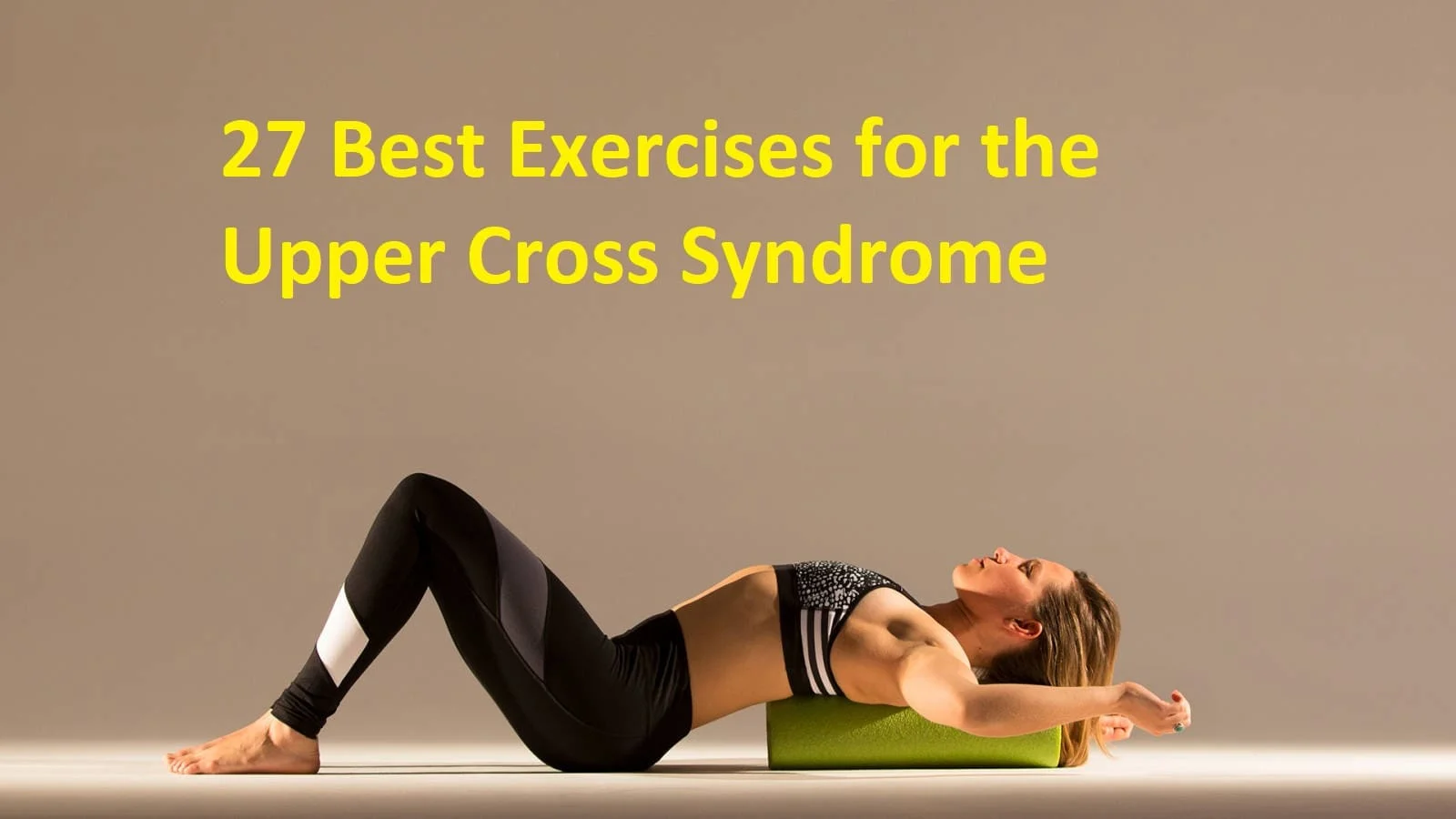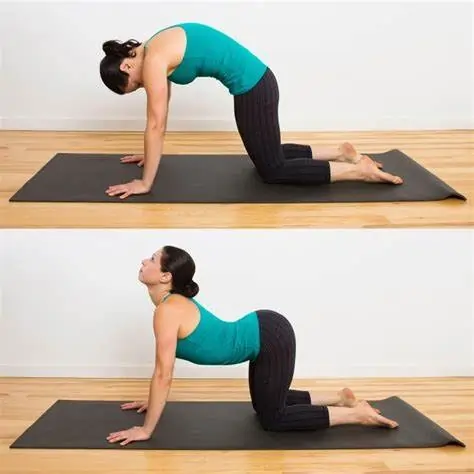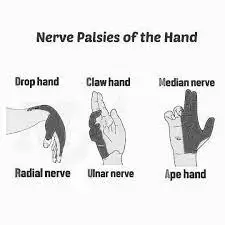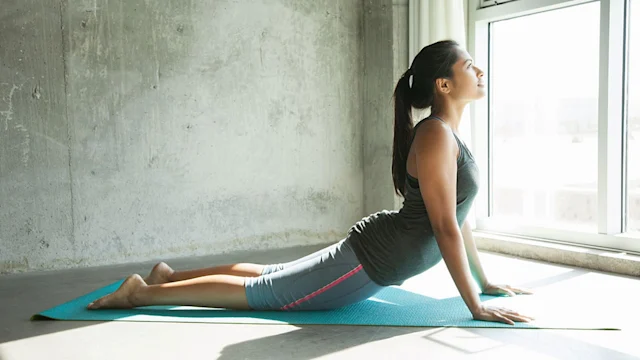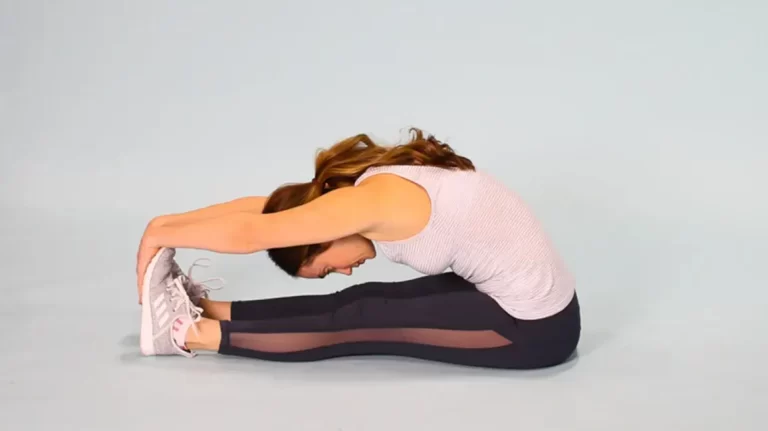24 Best Exercises for the Upper Cross Syndrome
Exercise is necessary for Upper Cross Syndrome (UCS) management and correction.
Muscle abnormalities in the upper body are an indicator of Upper Cross Syndrome (UCS), a postural disorder. It usually happens as a result of extended periods of bad posture, like bending over or hunching over a computer. In the neck, shoulders, and upper back, Upper Cross Syndrome can cause pain, discomfort, and decreased range of motion.
Exercises for the Upper Cross Syndrome work on particular muscle groups to stretch and strengthen tense muscles, which improves posture and reduces pain.
What is the Upper Cross Syndrome?
A muscle imbalance between the middle-to-upper thoracic spine and the anterior and posterior chains of the cervical spine is referred to as “upper cross syndrome.” The deformity of the neck, shoulder, and chest muscles is a characteristic of upper crossed syndrome (UCS), which typically comes on by poor posture.
The primary contributing factor of most cases of upper crossed syndrome (UCS) is continuous poor posture. particularly pushing the head forward while standing or spending a lot of time seated.
Upper Cross Syndrome can be treated with a combination of stretching, strengthening, and changes to your diet. By treating muscular weakness, muscle-strengthening exercises can support a state of good alignment and posture.
Muscle-stretching exercises help relieve tension and balance out the stress in the weak and tight muscles. Lifestyle changes, like reducing or eliminating repetitive activities and maintaining good posture, are also important in treating the disease’s underlying cause.
Upper Cross Syndrome: What causes it?
- Upper Cross Syndrome may likely develop in people with certain genetic conditions
- However, bad posture that continues to exist for a long time is usually the cause of the problem.
- The illness is frequently linked to certain behaviors, such as staring down at your phone or working at a desk.
- However, a few jobs may require you to sit or stand with your head forward and your shoulders collapsed.
Upper Cross Syndrome The consequences (Poor Posture):
- The glutes and core are less engaged when people are bending over when sitting.
- It puts strain on the lower back by shortening the hip flexors and hamstrings. This might cause pain.
- People who have upper cross syndrome may also experience difficulties due to repetitive motions of the neck, shoulders, and chest muscles.
- The most typical symptom was neck aches.
- Their heads were positioned forward as well.
- The muscles in the upper back, neck, chest, and shoulders become hyperactive and underactive with time as a result of poor posture.
- This makes the muscle imbalance even worse. This starts an unhealthy cycle.
- Bad posture contributes to muscle imbalance, which leads to even poorer posture.
- Reversing this pattern is essential for improving wellness and health.
- Kyphosis may arise in cases of undiagnosed and untreated upper cross syndrome.
- The cervical and thoracic spine bend in kyphosis.
- It is commonly described as having a bent back.
- Even though this condition is treatable, dealing with it is more difficult.
What signs and symptoms are present?
Individuals with upper cross syndrome frequently have rounded shoulders, scapular winging, and a forward head posture. The extension of one or both shoulder blades is known as scapular swinging. You may also have one or more of the following symptoms if you have upper cross syndrome;
- A feeling of stress on the back of the neck
- Pain in the upper arm
- Tingling
- Numbness
- Stiffness in the upper back and shoulders
- Chest tightness and pain
- Back pain in the lower back
- A weakness in the cervical region
- Headache
- Restricted movement in the shoulders and neck
The following are some benefits of exercise for upper cross syndrome:
If you exercise regularly, you can benefit from the following:
- Strengthens weakened muscles.
- Minimize tenseness or stiffness.
- Improvements in performance in daily activities
- You may be able to restore your mobility with exercise.
- Improving coordination.
- Improve your posture and relax your tense muscles.
- Reduce pain
- Improve mobility
Exercises for the Upper Cross Syndrome:
Exercise along with posture adjustments is the most effective treatment for upper crossed syndrome. Even though stretching can be quite uncomfortable for some people, Moderate exercise is still important because stopping activity may lead to stiffness and tightness.
Chin Tucks
- Maintain a relaxed posture for your shoulders and neck first.
- Looked directly ahead.
- Next, smoothly slide your chin back straight; do not hold your breath as you tuck your chin against your neck.
- A slight pulling around your upper neck will be felt.
- Additionally, keep in mind not to bend your neck forward or move your head up or down.
- Hold this position for a few seconds.
- Again, extend your chin forward.
- Then return to your neutral position.
- Then relax.
- Repeat this exercise 5 to 10 times.
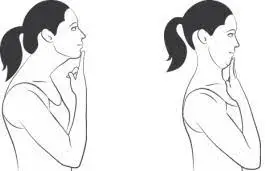
Isometric Neck Strengthening
- Put the palm of one hand on your forehead while you’re seated.
- Press your forehead softly on your hand, and let it slightly resist you.
- Try not to use your head to push the hand back.
- Keep the posture for a short while.
- To stretch and strengthen your neck on all sides, repeat the exercise with your hand on the left side of your head, pushing against resistance as you move in that direction, then the right side, and lastly the back of your head.
- Then return to your neutral position.
- Then relax.
- Repeat this exercise 5 to 10 times.
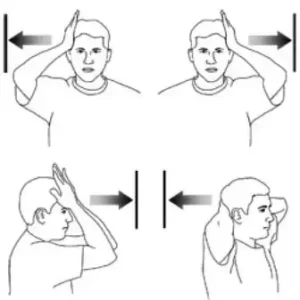
Reverse fly
- Take a standing posture on the ground to begin.
- Step onto the middle of the band.
- Keep your back straight and long, your hips articulating, your knees slightly bent, and your body slightly bent forward throughout the exercise.
- Lift the band and extend it to the sides.
- Squeeze the shoulder blades together.
- Hold this position for a few seconds.
- Then return to your neutral position.
- Then relax.
- Repeat this exercise 5 to 10 times.

Back Rows with band
- To begin, take a seat on the floor and spread your legs wide in front of you.
- Keeping the grips in place, tighten the band around the feet.
- After that, make a loop on each foot by surrounding it again and putting the ends inside.
- Sit up straight and tense your abs while holding the handles in front of you with your elbows bent at your sides.
- Once your elbows are close to your sides and behind you, pull the handles back.
- Hold this position for a few seconds.
- Release progressively.
- Then return to your neutral position.
- Then relax.
- Repeat this exercise 5 to 10 times.
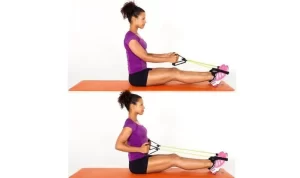
Quadruped Thoracic Rotation Stretch
- Take a quadruple posture to start. This means that you should get down on all fours.
- Put your hand on your ear so that the elbow is pointed sideways.
- Your other hand should be supporting your body on the floor.
- Raise the elbow of the hand resting on your ear above shoulder level while maintaining your spine in a neutral position.
- This will open your chest up toward the sky.
- Throughout this movement, keep your eyes always following your elbow.
- This supports the natural alignment of the neck and spine.
- Stabilize yourself by stabilizing your core.
- Make sure you complete the repetitions carefully and slowly for the entire exercise.
- Then return to your neutral position.
- Then relax.
- Repeat this exercise 5 to 10 times.
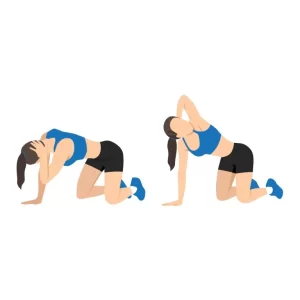
Corpse-Pose
- Place your hands firmly on the ground and sit with your knees bent.
- Stretch your legs out from your back, toes toward the ceiling.
- Keep your head in the center; do not let it slide to either side.
- Reach your arms down to the mat’s bottom, placing your hands’ backs on the ground.
- Remember to strengthen your shoulders and chest.
- Your lips, tongue, throat, and cheeks should all be relaxed.
- Slowly shift your eyes down toward your heart, letting them drop deeply.
- Maintain calm and lie in a single position for around five minutes.
- Take a deep breath as you slowly turn to the side to come out of the position.
- Then return to your neutral position.
- Then relax.
- Repeat this exercise 5 to 10 times.
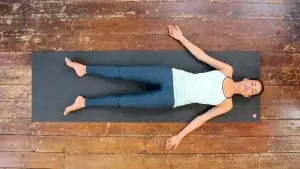
Pose of Warrior 1 (Virabhadrasana I)
- Start by getting to your feet and moving forward with your right foot three to four feet in front of your left foot.
- Bend your right knee to a 90-degree angle so that it is in line with your right ankle and your right thigh with the floor.
- Turn your left foot out slightly while keeping your left leg straight.
- Inhale deeply while pulling your chin into your chest, raising both arms straight up toward the ceiling, and pressing your shoulder blades together.
- Breathe out to release the posture, then stand up straight afterward.
- Then return to your neutral position.
- Then relax.
- Repeat this exercise 5 to 10 times.
- Shift one foot over and repeat the movement.
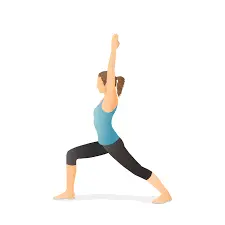
Levator Scapula Stretch
- Take a seat on the chair or table to start.
- Maintain proper posture with straight shoulders and back.
- Bending the elbows, raise the arm to a ninety-degree angle.
- Check the space around the arms.
- Stretch for a little time long.
- Hold this position for a few seconds.
- Then return to your neutral position.
- Then relax.
- Repeat this exercise 5 to 10 times.
- On the other side, repeat the stretch.
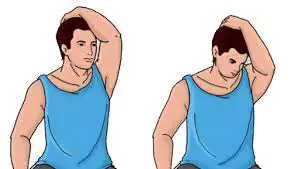
Biceps Stretch
- Begin by taking a comfortable position with your back against a wall, 5 to 6 inches away.
- Place your hand palm down, raise your arm on the affected side, and use your thumb side to try to make contact with the wall.
- Always maintain a straight arm.
- Move your body away from your lifted arm as soon as you start to feel a stretch in your muscles.
- Hold this position for a few seconds.
- Then return to your neutral position.
- Then relax.
- Repeat this exercise 5 to 10 times.

Cat-Cow Pose
- To start, get down on your hands and knees in the tabletop position on the ground.
- Keep your back straight.
- Keep both of your feet and hands firmly on the ground.
- Then inhale, lift your eyes, and allow the air to fill your belly.
- Hold your body like this for a short amount of time.
- Then, as you release the breath, raise your spine to the ceiling and put your chin into your chest.
- Next, push your chin up against your chest and bend your back toward the ceiling as you release the breath.
- As you behave, a gentle stretch is being applied to your lower back.
- Hold this position for a few seconds.
- Then return to your neutral position.
- Then relax.
- Repeat this exercise 5 to 10 times.

Child’s Pose
- Take a comfortable bending position to begin.
- Maintaining the alignment of your knees and hips.
- Inhale, then extend forward to lower your body.
- Press your forehead firmly against the surface of the ground.
- Holding your arms straight out in front is fine.
- Hold this position for a short time.
- Exhale.
- Then return to your neutral position.
- Then relax.
- Repeat this exercise 5 to 10 times.

Superman pose
- To begin, lie down on your stomach and take a deep breath.
- Raise your arms in front of you while maintaining a straight posture.
- keeping a level-headed position.
- At this point, gradually lift your arms and legs to a comfortable height off the ground.
- To tighten your core muscles, lift your tummy slightly off the ground.
- Your lower back muscles are tightening up inside you.
- Hold this position for just a short moment.
- Then return to your neutral position.
- Then relax.
- Repeat this exercise 5 to 10 times.

Forearm Plank
- Lie down on the ground and relax for a little.
- Place your forearms directly below your shoulders.
- Next, push your knees and forearms to gradually raise your body off the ground.
- Lift your body into a comfortable position.
- Push your toes under as you raise your knees.
- That positions your body in a straight line.
- Hold this posture for a few seconds.
- Then return to your neutral position.
- Then relax.
- Repeat this exercise 5 to 10 times.
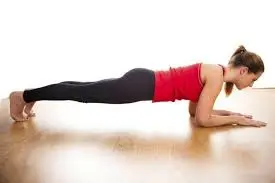
Cobra Pose
- Set your hands straight on the ground at your sides.
- Keep your sides together and your elbows straight out.
- Take a step back and maintain a neutral neck posture while you look directly down at your mat.
- To raise your chest off the ground, take a deep breath.
- Roll your shoulders back and keep your chest on the ground.
- Always maintain your elbows by your sides.
- Don’t let them go in separate directions.
- Keep a neutral neck posture.
- Don’t take your eyes off the ground.
- Hold this position for a few seconds.
- To get back on the floor, exhale.
- Then return to your neutral position.
- Then relax.
- Repeat this exercise 5 to 10 times.
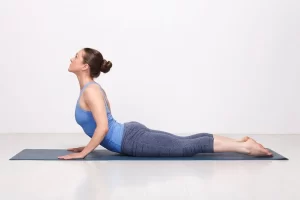
Supine Spinal Twist
- Bend your knees and place your feet flat on the floor while on your back.
- Make a T shape with your hands by extending them to the sides.
- Maintain your shoulders level on the ground as you progressively rotate your leg to one side.
- For a short time frame, maintain this position.
- Then return to your neutral position.
- Then relax.
- Repeat this exercise 5 to 10 times.
- On the opposite leg, finish up the workout.
- If the stretch is too much for you, put a cushion or layer of blankets below your knees as you move to each side.
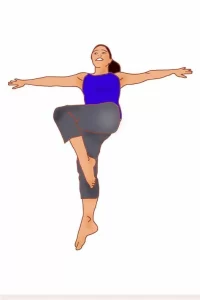
Upper Trapezius Stretch
- With your head and neck in a neutral position and your shoulders aligned with your ears, take a seat upright in a chair.
- You should be grasping the chair’s edge with your right hand.
- Move your chin slightly.
- With your head tilted to the left, look straight ahead.
- Positioning your left hand over the right side of your head.
- Make a small head movement to the left.
- Hold on for a short moment.
- Use slight pressure to extend the stretch.
- Avoid arching your head to one side.
- Then return to your neutral position.
- Then relax.
- Repeat this exercise 5 to 10 times.
- Turn the sides over and continue.
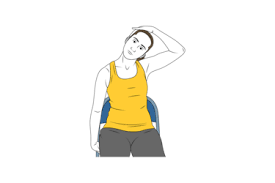
Shoulder Blade Retraction
- Place yourself in a comfortable posture on the ground to get started.
- Keep your neck and head relaxed.
- Now squeeze your shoulder blades together.
- For a short while, hold it.
- Then return to your neutral position.
- Then relax.
- Repeat this exercise 5 to 10 times.
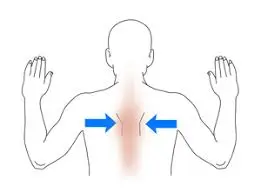
Resistance band pulls
- First, take a comfortable position.
- Place a tiny resistance band on top of your hand.
- Keep a ninety-degree elbow posture.
- Spread your wrists widely inside the band.
- Hold this posture for a short while.
- Then return to your neutral position.
- Then relax.
- Repeat this exercise 5 to 10 times.

Door Way Shoulder Stretch
- Position yourself at an open doorway.
- Each arm should be raised to the side with the palms facing the front and the elbows bent at a 90-degree angle.
- Place your palms on the door frame.
- If this is too painful, consider bending your elbows just a little bit.
- Step forward carefully with one foot.
- Your chest and shoulder muscles need to feel stretched.
- When standing, keep your posture upright.
- Hold this posture for a short while.
- Then return to your neutral position.
- Then relax.
- Repeat this exercise 5 to 10 times.

Wall Angels
- Place your feet apart from the wall as you stand.
- Put your head, shoulders, back, and butt onto the wall.
- Pull your belly button toward your spine to try to start with a neutral spine.
- While keeping your lower back slightly away from the wall, pull your ribs in and down, feeling the rear of your rib cage connect to the wall.
- Try to get your back to touch the wall by lowering your chin a little bit.
- Try putting a little pillow behind your head if you’re having trouble getting your head on the wall.
- Then, extend your arms straight up and place them on the wall above, trying to make a “V” shape with your hands by touching the wall with the backs of them.
- Next, slide your hands down the wall until they are slightly over your shoulders, bending your elbows along the way.
- Hold your head, trunk, and butt against the wall in the meantime.
- Simply go down as low as you can without hurting yourself and keeping proper posture (a little stretch is normal).
- Hold this posture for a short while.
- Then return to your neutral position.
- Then relax.
- Repeat this exercise 5 to 10 times.
Reverse shoulder stretch
- As you begin, take a wise posture.
- While keeping your elbows locked behind you, slowly extend your arms behind your body.
- The muscles that connect your shoulder blades should feel stretched.
- Avoid going too far beyond your comfort zone.
- Minor muscular pain or burning is fine, but not pain in the arms or neck.
- Avoid putting your shoulders behind your ears.
- Hold this posture for a short while.
- Then return to your neutral position.
- Then relax.
- Repeat this exercise 5 to 10 times.
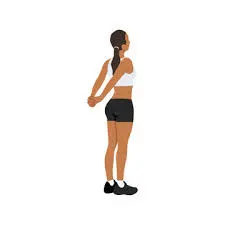
Neck foam roller
- Place your neck on the foam roller where it meets your head at the top.
- Move your head slowly to the right, stopping where you feel a limitation.
- Let out a breath and turn your head to the left.
- Then return to your neutral position.
- Then relax.
- Repeat this exercise 5 to 10 times.
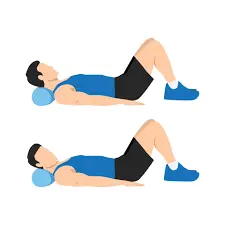
Bear Hugs
- Starting from the ground, take a comfortable position.
- Hold a theraband or cables in the middle of your shoulders and loop them around.
- This is the time to raise your arms straight out to the side, 90 degrees apart.
- As much as possible, you should keep your arm straight.
- Slide the band or cable inside and forward as you’re hugging someone.
- For a few seconds, hold yourself in the position where your hands meet.
- Then return to your neutral position.
- Then relax.
- Repeat this exercise 5 to 10 times.
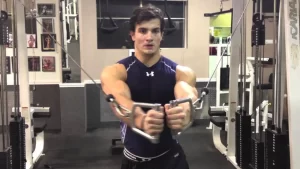
Supine Chin Tuck
- Begin in a comfortable lying position on the bed or table.
- When lying down on your back, pull your chin in, but keep your head from looking up at your chest.
- From here, carefully raise your head 3 to 4 inches off the floor on the surface of the bed.
- Hold this position for a few seconds.
- Then return to your neutral position.
- Then relax.
- Repeat this exercise 5 to 10 times.
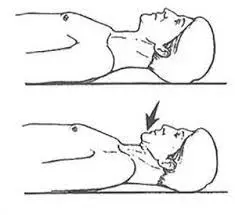
What safety precautions are required when working out?
It’s important to speak with your doctor or physical therapist before starting any exercise program to make sure the exercises are suitable for your condition and to get individualized advice.
- Warm up and stretch before working out.
- Straighten your back while exercising.
- Avoid doing intense exercise.
- Exercise should be stopped if you feel any sudden discomfort or pain.
- Take a break in between workouts.
- Keep yourself hydrated.
- Put on easy shoes and relaxed clothes.
When will you stop doing exercise?
- Intense pain in the muscles
- You are a transmissible disease.
- If there is any pain or numbness.
- Fever
- Headache
- If exercise causes pain, stop.
Upper Cross Syndrome Preventive Measures:
- Receive sufficient aerobic exercise, ideally from low-impact exercises like walking, swimming, and cycling, for 30 to 35 minutes every day.
- Perfection can be achieved via practice.
- Make it a habit to hold your head neutral and your shoulders back during the day to maintain good posture.
- Identifying and avoiding, for as long as possible, behaviors, movements, or activities that worsen and aggravate symptoms. The pain doesn’t go away when you relax.
- You can cut down on how much time you spend reading, driving, watching TV, or using laptops and computers by taking breaks every ten to fifteen minutes when working on difficult tasks.
- Look at your phone or tablet at eye level rather than lowering your look to it for extended periods to prevent the worry about “text neck” and upper cross syndrome.
- It is advised to stretch the muscles that are tight in the rear neck, shoulders, and chest, strengthen the weakening muscles in the upper front neck and lower shoulders, and perform the workouts a couple of times during the day.
Summary
It takes time to develop the upper cross syndrome. This particular set of muscular imbalances typically comes on by extended bad posture. People who have the illness therefore, frequently end up with hunched shoulders and a forward head posture. Also possible are stiffness and pain in the shoulders or neck.
Postural exercises to correct muscle imbalances have been proven to be an effective treatment for upper cross syndrome. However, to help avoid it entirely, pay attention to your posture and lead an active lifestyle all day long.
FAQs
What is an upper cross syndrome?
The term “upper back pain” refers to the imbalance of the muscles in your neck, shoulders, and chest, with some being overly rigid and others too weak. These muscles combine to form the appearance of an X when viewed from the side.
Is it possible to treat upper cross syndrome?
It can be resolved with suitable regular physical activity. Usually, it comes on by improper posture or repetitive motions.
Which type of treatment works best for upper cross syndrome?
The majority of effective UCS therapies usually center on movement, flexibility, and spinal modifications. Many issues related to upper cross syndrome can be minimized by making these changes, strengthening weak muscles, controlling posture, and regularly stretching.
Which exercises are good for upper-crossed syndrome?
Isometric Neck Strengthening
Upper Trapezius Stretch
Shoulder Blade Retraction
Resistance band pulls
Plank
Door Way Shoulder Stretch
How frequently should an individual who has upper cross syndrome exercise?
It is possible to perform the upper cross syndrome exercises for at least 30 to 40 minutes every day. You will benefit from a daily program of gentle stretching and exercise.
Which elements contribute to upper cross syndrome?
While a variety of activities can result in upper crossing syndrome, the majority of cases are caused by poor posture, particularly from prolonged sitting or standing with the head forward. Among the activities that encourage this posture include driving and using a laptop or computer.
Does upper cross syndrome benefit from yoga?
Additionally, yoga has a few special benefits that can help with Upper Cross Syndrome: it can promote bending backward, stimulate the parasympathetic nervous system response, and relieve tension via the use of breathing techniques.
Is upper cross syndrome well treated with Pilates?
The results indicated that in patients with upper cross syndrome, the Pilates exercise program beat a conventional physical therapy program in terms of improving the curvature of the spine.
How does upper cross syndrome express itself?
The mid and upper back muscles, the serratus and trapezius, weaken as a result of upper cross syndrome. The result is stiffness in the neck and chest muscles. This results in a reduction in range of motion and pain throughout the upper body, including the neck and shoulders.
Can upper cross syndrome be controlled?
For individuals with UCS, therapy programs that include a variety of exercises and strategies to correct dysfunctional posture and repair neuromuscular imbalances are successful in reducing pain and relieving postural deviations and neck impairments.
Why am I so weak in my upper back?
Bad posture and being inactive can cause the muscles in your back to become weaker or deconditioned. Bending over a desk while seated, for instance, might gradually weaken the muscles in your upper back and raise your risk of injuries.
In what way does upper-crossed syndrome (UCS) show itself?
The head being continuously or frequently forward-positioned is one of the common symptoms of upper crossing syndrome. neck-containing spine’s inward curvature (increased cervical lordosis)
Does upper cross syndrome benefit from yoga?
There are a few other special advantages of yoga for people with Upper Cross Syndrome: It can include breathing exercises that prevent Upper Cross Syndrome by encouraging backbends, activating the parasympathetic nervous system response, and relieving tension.
References:
- September 21, 2023; Passalacqua, B. 7 Yoga Pose Adjustments to Correct Your Neck Slouch for Upper Cross Syndrome. inhaling deeply. yogic therapy for that bothersome neck: https://breathingdeeply.com/
- GoodRx – Inaccuracy (n.d.). musculoskeletal/upper-cross syndrome on https://www.goodrx.com
- B. Evergreen (2021, Dec. 20). Upper Cross Syndrome: How to Correct Posture. Coquitlam, Langley, and Surrey are home to Evergreen Rehab and Wellness. How to Correct Your Posture in Upper Cross Syndrome: https://evergreenclinic.ca/
- Turetsky, L. (4 July 2023). Exercises, Causes, Symptoms of Upper Crossed Syndrome. Exercises for Upper Crossed Syndrome by Back Intelligence. https://backintelligence.com/
- B. Young (2018) 18 September. Healthline. 2017. https://www.healthline.com/health/upper-crossed-syndrome
- Image 3, On January 14, 2022, Cronkleton, E. Six Shoulder Resistance Band Exercises. Healthline. https://www.healthline.com/health/exercise-with-a-band
- Image 4, 118260396 – Virtual Shop. (n.d.). 118260396.html is the product detail page for https://svipolylatur.org.
- Image 5, L. Putra (2023, Feb. 3). Download the exercise of a woman performing a quadruped rotation or thoracic rotation. Vecteezy.com/vector-art/18862590-woman-doing-exercise-in-thoracic-rotation-pose-or-quadruped-rotation-flat-vector-illustration-isolated-on-white-background: Flat vector illustration
- Image 7, Pocket Yoga: A Dictionary of Yoga Poses (n.d.). Warriors I pose at pocketyoga.com
- Image 18, February 1, 2024: Cpt, C. F. How to Perform a Mid-Back Pull using Resistance Bands. Get Well, U. Freytag Chris. This is a resistance band mid-back pull exercise from GetHealthyu.com.
- Image 21, Look Through 102 Stock Images, Vectors, and Videos Tagged with “Shoulder Stretch” (As of now). Stock.Adobe.com/search?k=%22shoulder+stretch%22 is the Adobe Stock URL.
- Image 22, Top Selling Items. (n.d.). This link will take you to https://www.talcasv.com.
- Image 23, January 16, 2013, J. C. For large and ripped chests, perform the bear hug fy pec exercise. YouTube. YouTube: https://www.youtube.com/watch?v=YEU7P18HyuA.
- Image 24, Online Store: 2811111 (n.d.). This product details page: https://ibestariov.life/2811111.html

